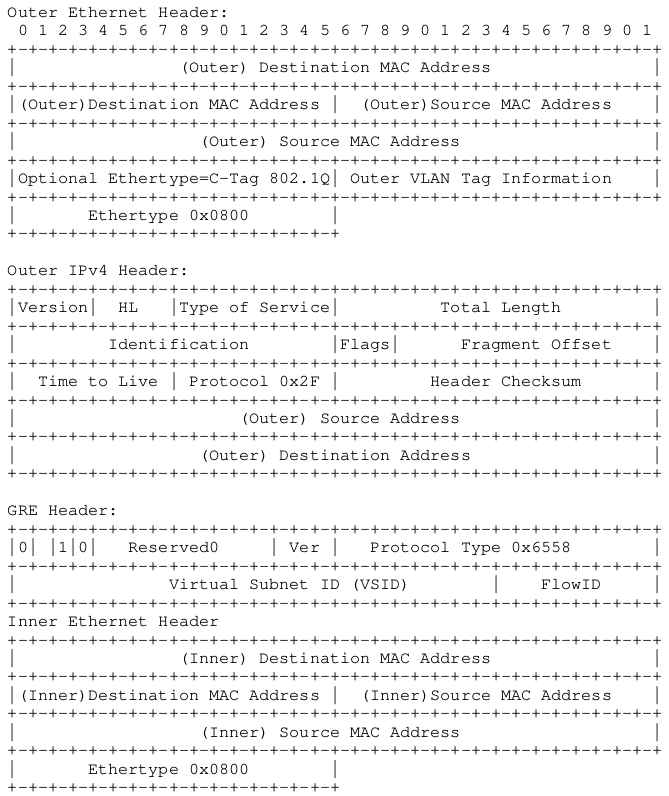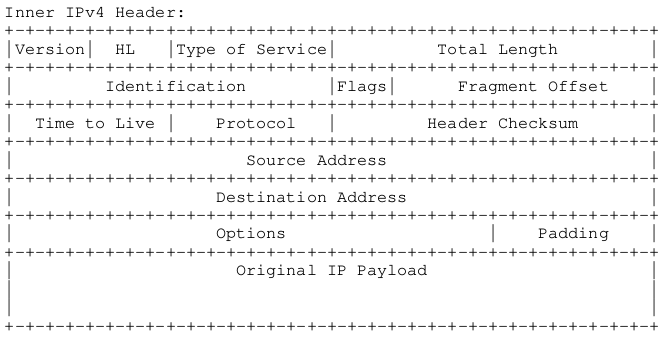#include "include/jgresa.h"
Detailed Description
General Encapsulation Protocol Security Association (GRESA)
See rfc2890, rfc2784, and rfc9187 for full details
Generic Routing Encapsulation (GRE) specifies a protocol for encapsulation of an arbitrary protocol over another arbitrary network layer protocol. This document describes extensions by which three fields, Checksum, Key, and Sequence Number, can be optionally carried in the GRE Header

Checksum Present (bit 0)
If the Checksum Present bit is set to one, then the Checksum and the Reserved1 fields are present and the Checksum field contains valid information. Note that a compliant implementation MUST accept and process this field
Key Present (bit 2)
If the Key Present bit is set to 1, then it indicates that the Key field is present in the GRE header. Otherwise, the Key field is not present in the GRE header
Sequence Number Present (bit 3)
If the Sequence Number Present bit is set to 1, then it indicates that the Sequence Number field is present. Otherwise, the Sequence Number field is not present in the GRE header
Reserved0 (bits 4-12)
A receiver MUST discard a packet where any of bits 1-5 are non-zero, unless that receiver implements RFC 1701. Bits 6-12 are reserved for future use These bits MUST be sent as zero and MUST be ignored on receipt
Version Number (bits 13-15)
The Version Number field MUST contain the value zero.
Protocol Type (2 octets)
The Protocol Type field contains the protocol type of the payload packet These Protocol Types are defined in [RFC1700] as "ETHER TYPES" and in [ETYPES]. An implementation receiving a packet containing a Protocol Type which is not listed in [RFC1700] or [ETYPES] SHOULD discard the packet
Checksum (2 octets)
The Checksum field contains the IP (one’s complement) checksum sum of the all the 16 bit words in the GRE header and the payload packet. For purposes of computing the checksum, the value of the checksum field is zero. This field is present only if the Checksum Present bit is set to one
Key Field (4 octets)
The Key field contains a four octet number which was inserted by the encapsulator. The actual method by which this Key is obtained is beyond the scope of the document. The Key field is intended to be used for identifying an individual traffic flow within a tunnel. For example, packets may need to be routed based on context information not present in the encapsulated data The Key field provides this context and defines a logical traffic flow between encapsulator and decapsulator. Packets belonging to a traffic flow are encapsulated using the same Key value and the decapsulating tunnel endpoint identifies packets belonging to a traffic flow based on the Key Field value
Sequence Number (4 octets)
The Sequence Number field is a four byte field and is inserted by the encapsulator when Sequence Number Present Bit is set. The Sequence Number MUST be used by the receiver to establish the order in which packets have been transmitted from the encapsulator to the receiver. The intended use of the Sequence Field is to provide unreliable but in-order delivery. If the Key present bit (bit 2) is set, the sequence number is specific to the traffic flow identified by the Key field. Note that packets without the sequence bit set can be interleaved with packets with the sequence bit set. The sequence number value ranges from 0 to (2**32)-1. The first datagram is sent with a sequence number of 0. The sequence number is thus a free running counter represented modulo 2**32. The receiver maintains the sequence number value of the last successfully decapsulated packet. Upon establishment of the GRE tunnel, this value should be set to (2**32)-1
When the decapsulator receives an out-of sequence packet it SHOULD be silently discarded. A packet is considered an out-of-sequence packet if the sequence number of the received packet is less than or equal to the sequence number of last successfully decapsulated packet. The sequence number of a received message is considered less than or equal to the last successfully received sequence number if its value lies in the range of the last received sequence number and the preceding 2**31-1 values, inclusive.
If the received packet is an in-sequence packet, it is successfully decapsulated. An in-sequence packet is one with a sequence number exactly 1 greater than (modulo 2**32) the last successfully decapsulated packet, or one in which the sequence number field is not present (S bit not set)
Network Virtualization Using Generic Routing Encapsulation (NVGRE)
See rfc7637 for full details
Conventional data center network designs cater to largely static workloads and cause fragmentation of network and server capacity. There are several issues that limit dynamic allocation and consolidation of capacity. Layer 2 networks use the Rapid Spanning Tree Protocol (RSTP), which is designed to eliminate loops by blocking redundant paths. These eliminated paths translate to wasted capacity and a highly oversubscribed network. There are alternative approaches such as the Transparent Interconnection of Lots of Links (TRILL) that address this problem
The network utilization inefficiencies are exacerbated by network fragmentation due to the use of VLANs for broadcast isolation. VLANs are used for traffic management and also as the mechanism for providing security and performance isolation among services belonging to different tenants. The Layer 2 network is carved into smaller-sized subnets (typically, one subnet per VLAN), with VLAN tags configured on all the Layer 2 switches connected to server racks that host a given tenant’s services. The current VLAN limits theoretically allow for 4,000 such subnets to be created. The size of the broadcast domain is typically restricted due to the overhead of broadcast traffic. The 4,000-subnet limit on VLANs is no longer sufficient in a shared infrastructure servicing multiple tenants
Data center operators must be able to achieve high utilization of server and network capacity. In order to achieve efficiency, it should be possible to assign workloads that operate in a single Layer 2 network to any server in any rack in the network. It should also be possible to migrate workloads to any server anywhere in the network while retaining the workloads’ addresses. This can be achieved today by stretching VLANs; however, when workloads migrate, the network needs to be reconfigured and that is typically error prone. By decoupling the workload’s location on the LAN from its network address, the network administrator configures the network once, not every time a service migrates This decoupling enables any server to become part of any server resource pool The following are key design objectives for next-generation data centers:
a. location-independent addressing
b. the ability to a scale the number of logical Layer 2 / Layer 3 networks, irrespective of the underlying physical topology or the number of VLANs
c. preserving Layer 2 semantics for services and allowing them to retain their addresses as they move within and across data centers
d. providing broadcast isolation as workloads move around without burdening the network control plane
This document describes use of the Generic Routing Encapsulation (GRE) header for network virtualization. Network virtualization decouples a virtual network from the underlying physical network infrastructure by virtualizing network addresses
Combined with a management and control plane for the virtual-to- physical mapping, network virtualization can enable flexible virtual machine placement and movement and provide network isolation for a multi-tenant data center
Network virtualization enables customers to bring their own address spaces into a multi-tenant data center, while the data center administrators can place the customer virtual machines anywhere in the data center without reconfiguring their network switches or routers, irrespective of the customer address spaces


For API Documentation:
- See also
- tinyxml2::tinyxml2
- ProtocolPP::jarray
- ProtocolPP::jgresa
- ProtocolPP::jgre
- ProtocolPP::jprotocol
- ProtocolPP::jsecass
For Additional Documentation:
The source code contained or described herein and all documents related to the source code (herein called "Material") are owned by John Peter Greninger and Sheila Rocha Greninger. Title to the Material remains with John Peter Greninger and Sheila Rocha Greninger. The Material contains trade secrets and proprietary and confidential information of John Peter Greninger and Sheila Rocha Greninger. The Material is protected by worldwide copyright and trade secret laws and treaty provisions. No part of the Material may be used, copied, reproduced, modified, published, uploaded, posted, transmitted, distributed, or disclosed in any way without prior express written consent of John Peter Greninger and Sheila Rocha Greninger (both are required)
No license under any patent, copyright, trade secret, or other intellectual property right is granted to or conferred upon you by disclosure or delivery of the Materials, either expressly, by implication, inducement, estoppel, or otherwise. Any license under such intellectual property rights must be express and approved by John Peter Greninger and Sheila Rocha Greninger in writing
Licensing information can be found at www.protocolpp.com/license with use of the binary forms permitted provided that the following conditions are met:
- Redistributions in binary form must reproduce the above copyright notice, this list of conditions and the following disclaimer in the documentation and/or other materials provided with the distribution
- Any and all modifications must be returned to John Peter Greninger at GitHub.com https://github.com/jpgreninger/protocolpp for evaluation. Inclusion of modifications in the source code shall be determined solely by John Peter Greninger. Failure to provide modifications shall render this license NULL and VOID and revoke any rights to use of Protocol++®
- Commercial use (incidental or not) requires a fee-based license obtainable at www.protocolpp.com/shop
- Academic or research use requires prior written and notarized permission from John Peter and Sheila Rocha Greninger
Use of the source code requires purchase of the source code. Source code can be purchased at www.protocolpp.com/shop
- US Copyrights at https://www.copyright.gov/
- TXu002059872 (Version 1.0.0)
- TXu002066632 (Version 1.2.7)
- TXu002082674 (Version 1.4.0)
- TXu002097880 (Version 2.0.0)
- TXu002169236 (Version 3.0.1)
- TXu002182417 (Version 4.0.0)
- TXu002219402 (Version 5.0.0)
- TXu002272076 (Version 5.2.1)
- TXu002383571 (Version 5.4.3)
The name of its contributor may not be used to endorse or promote products derived from this software without specific prior written permission and licensing
THIS SOFTWARE IS PROVIDED BY THE COPYRIGHT HOLDER AND CONTRIBUTOR "AS IS" AND ANY EXPRESS OR IMPLIED WARRANTIES, INCLUDING, BUT NOT LIMITED TO, THE IMPLIED WARRANTIES OF MERCHANTABILITY AND FITNESS FOR A PARTICULAR PURPOSE ARE DISCLAIMED. IN NO EVENT SHALL THE COPYRIGHT OWNER OR CONTRIBUTORS BE LIABLE FOR ANY DIRECT, INDIRECT, INCIDENTAL, SPECIAL, EXEMPLARY, OR CONSEQUENTIAL DAMAGES (INCLUDING, BUT NOT LIMITED TO, PROCUREMENT OF SUBSTITUTE GOODS OR SERVICES; LOSS OF USE, DATA, OR PROFITS; OR BUSINESS INTERRUPTION) HOWEVER CAUSED AND ON ANY THEORY OF LIABILITY, WHETHER IN CONTRACT, STRICT LIABILITY, OR TORT (INCLUDING NEGLIGENCE OR OTHERWISE) ARISING IN ANY WAY OUT OF THE USE OF THIS SOFTWARE, EVEN IF ADVISED OF THE POSSIBILITY OF SUCH DAMAGE
The documentation for this class was generated from the following file:
- include/jgresa.h